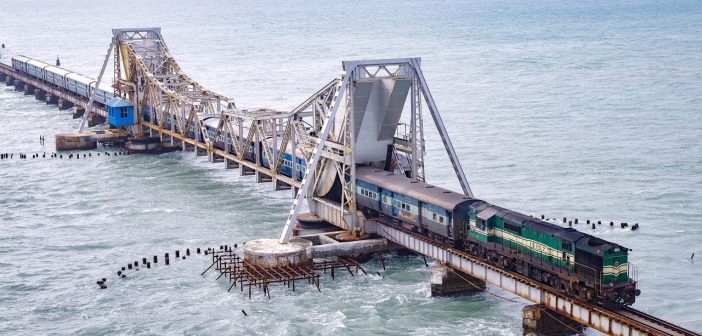India has achieved a monumental feat in infrastructure development with the completion of the New Pamban Bridge, the nation’s first vertical lift railway sea bridge. Scheduled for inauguration by Prime Minister Narendra Modi on April 6, during the auspicious occasion of Ram Navami, this 2.08-kilometer marvel stretches across the Palk Strait, connecting the sacred Rameswaram Island to mainland Tamil Nadu. The bridge not only replaces the iconic century-old structure but also ushers in a new era of innovation, sustainability, and connectivity.
Constructed at a cost of 5.5 billion rupees by the Rail Vikas Nigam Limited (RVNL), a Navratna public sector undertaking under the Ministry of Railways, the New Pamban Bridge stands as a testament to India’s engineering prowess. It integrates cutting-edge technology with historical and cultural reverence, ensuring a seamless blend of tradition and modernity.
The original Pamban Bridge, a cantilever Scherzer Rolling Lift design built in 1914, served as a vital link for over a century, facilitating pilgrimage, trade, and tourism. However, the demands of modern transportation and the challenges posed by the harsh marine environment called for a resilient and technologically advanced replacement. Sanctioned in 2019, the New Pamban Bridge addresses these needs, embodying durability, efficiency, and a vision for the future.
The centerpiece of the bridge is its 72.5-meter-long vertical navigational span, capable of being lifted up to 17 meters to allow larger ships to pass underneath. The substructure has been designed to support two tracks, even though the initial configuration accommodates a single line. Constructed using modern materials and engineering techniques, including stainless steel reinforcement, high-grade protective paint, and fully welded joints, the bridge promises an impressive lifespan exceeding a century.
Its innovative polysiloxane coating and advanced corrosion protection techniques ensure structural integrity despite the harsh marine conditions. Standing three meters higher than its predecessor, the bridge not only enhances sea connectivity but also bolsters maritime integration.
The New Pamban Bridge is not just a marvel of design but also an emblem of resilience, built to withstand the seismic activity, cyclones, and strong sea currents typical of the region. The construction faced numerous challenges, including logistical complexities and environmental obstacles, such as the turbulent waters of the Palk Strait and unpredictable weather patterns. Ingenious methods like the “Auto Launching Method based on Relationship Principle,” developed by Suntech Construction Engineering Consultants and verified by IIT Madras, were employed to overcome these hurdles.
The installation of the vertical lift span involved meticulous planning and execution, using pier-to-pier launching techniques and advanced hydraulic systems to ensure precision. The bridge also incorporates state-of-the-art safety features, such as a wind velocity monitoring system at Pier No. 38. This system uses an anemometer to measure wind speed and automatically halts train operations if speeds exceed 58 kilometers per hour, ensuring safe passage across the Palk Strait.
Another innovative addition is a system to convert humidity in the air into clean drinking water for staff stationed in the mid-sea electrical room that operates the vertical lift span. This eco-friendly solution underscores the project’s commitment to sustainability.
The bridge’s construction involved transporting and assembling over 1,400 tons of steel components under challenging conditions, including strong winds and limited timeframes dictated by tidal changes. Despite these obstacles, the project was completed without a single injury, reflecting the dedication and ingenuity of the engineers and workers involved.
Beyond its engineering excellence, the New Pamban Bridge is set to significantly boost regional transportation and economic development. By accommodating higher volumes of traffic and allowing for faster trains, it promises enhanced connectivity for pilgrims, tourists, and the local economy. The seamless integration of maritime and rail transport is expected to facilitate smoother trade and travel, creating new opportunities for growth in the region.
The New Pamban Bridge joins the ranks of globally celebrated infrastructure icons, such as the Golden Gate Bridge in the United States and the Tower Bridge in London. It represents a leap forward in India’s infrastructure capabilities, standing as a proud testament to the nation’s ability to tackle complex challenges and deliver world-class solutions.
As the bridge prepares to welcome its first trains and ships beneath its span, it symbolizes not just a technical achievement but a vision realized. It is a beacon of progress, resilience, and innovation—a fitting tribute to the legacy of its historic predecessor and a promise of a brighter, better-connected future.





